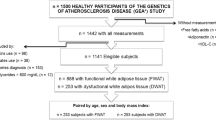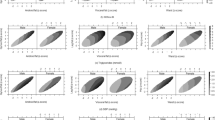Abstract
OBJECTIVE: To determine if obesity measures are related to measures of low-density lipoprotein (LDL) size and LDL subfractions in a population of Mexican-Americans with high prevalence of obesity.
METHODS: LDL size phenotypes, based on nondenaturing gradient gel electrophoresis and staining for cholesterol (using Sudan black B), were determined for 313 unrelated Mexican-American participants in the San Antonio Family Heart Study. LDL size measures included predominant particle diameter, median diameter (particle diameter, where half the LDL absorbance is on larger and half on smaller LDLs) and cholesterol level in various LDL subfractions. Adiposity traits included two measures of general body fatness (body-mass index (BMI) and fat mass determined with bioimpedance) and three measures of regional fat deposition (waist-to-hip ratio (WHR), waist circumference and subscapular-triceps skinfold ratio (STR)).
RESULTS: Gender and diabetes were significantly associated with most LDL size measures. In addition, BMI, WHR, waist circumference and STR were significantly (P<0.05) associated with several LDL size measures. Stepwise regression analysis (including adjustment for age, gender and diabetes status) showed that in every case, the strongest adiposity correlate of LDL size, was WHR, which reflects deposition of visceral fat. If triglyceride (TG) concentration was also included in the models, no fat measure was independently correlated with LDL size, suggesting that elevation of TG, associated with increased adiposity, was more directly correlated with LDL size.
Supporting this interpretation, we found that WHR was also the strongest correlate of TG among adiposity measures. Regression analysis of the LDL particle size cholesterol profile expressed in 0.1 nm increments revealed a positive correlation of WHR and LDLs in the interval 25.9–26.3 nm (P<0.05) and a negative correlation of BMI with LDLs in the interval 27.3–28.1 nm (P<0.05).
CONCLUSION: These results suggest that different adiposity measures, reflecting different aspects of fat deposition, are related to specific LDL size intervals. We speculate that increased deposition of fat, particularly visceral fat, is associated with increased TG, which in turn is associated with decreases in LDL particle size.
This is a preview of subscription content, access via your institution
Access options
Subscribe to this journal
Receive 12 print issues and online access
$259.00 per year
only $21.58 per issue
Buy this article
- Purchase on Springer Link
- Instant access to full article PDF
Prices may be subject to local taxes which are calculated during checkout
Similar content being viewed by others
Author information
Authors and Affiliations
Rights and permissions
About this article
Cite this article
Rainwater, D., Mitchell, B., Comuzzie, A. et al. Relationship of low-density lipoprotein particle size and measures of adiposity. Int J Obes 23, 180–189 (1999). https://doi.org/10.1038/sj.ijo.0800813
Received:
Revised:
Accepted:
Published:
Issue Date:
DOI: https://doi.org/10.1038/sj.ijo.0800813
Keywords
This article is cited by
-
Associations of diet quality and food consumption with serum biomarkers for lipid and amino acid metabolism in Finnish children: the PANIC study
European Journal of Nutrition (2023)
-
The effects of fat consumption on low-density lipoprotein particle size in healthy individuals: a narrative review
Lipids in Health and Disease (2021)
-
Association of Body Mass Index and Lipid Profiles: Evaluation of a Broad Spectrum of Body Mass Index Patients Including the Morbidly Obese
Obesity Surgery (2011)
-
The Lipid Accumulation Product and All‐cause Mortality in Patients at High Cardiovascular Risk: A PreCIS Database Study
Obesity (2010)
-
Tracking and determinants of LDL particle size in healthy children from 7 to 11 years of age: the STRIP Study
European Journal of Pediatrics (2009)



